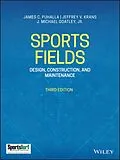THE UPDATED, AUTHORITATIVE GUIDE TO SPORTS FIELD MANAGEMENT THAT INCLUDES THE LATEST DEVELOPMENTS IN, AND ON, THE FIELD
The updated Third Edition of Sports Fields: Design, Construction, and Maintenance is a comprehensive reference for professionals who are responsible for the design, construction, renovation, and maintenance of athletic facilities. This book contains illustrative examples of specific design elements of the most popular sports facilities. This Third Edition contains new chapters on safety, public relations, and professionalism for future sports field managers, as well as fresh drawings and photos that highlight innovative field layout, grading, irrigation, and drainage. All-new case studies review best practices and techniques for sports fields ranging from youth and high school fields to fields that are designed for professional athletes. This text is also an ideal resource for anyone studying for Sports Field Manager Certification (offered by STMA).
* Features new case studies that include design and management best practices for all levels and types of sports facilities
* Offers new chapters on safety, public relations, and professionalism for future sports field managers
* Includes new illustrations and photos of innovative field layout, grading, irrigation, and drainage
* Contains the most recent information on sand-based field systems and synthetic turf
* Presents discussions of a range of fields including baseball, softball, football, soccer, lacrosse, field hockey, tennis, and track and field
Sports Fields: Design, Construction, and Maintenance, Third Edition is a blueprint for field managers, designers, and builders for successful sports field projects.
Autorentext
JAMES C. PUHALLA is experienced in the sports field industry, specializing in the design, construction, renovation, and maintenance of sports fields and athletic facilities.
JEFFREY V. KRANS, PhD.,??is a former Professor of Agronomy at Mississippi State University, is a turfgrass breeding and physiology specialist.
J. MICHAEL GOATLEY, JR. PhD., is a Professor and Extension Turfgrass Specialist with years of research and teaching experience in sports turf management at Mississippi State University and Virginia Tech.
Inhalt
About the Authors xi
About the STMA xiii
Preface xv
Part 1 Principles of Sports Turf Culture 1
1 Turfgrasses 3
1.1 Introduction 3
1.2 Biology and Identification 4
1.3 Turfgrass Types 11
1.4 Turfgrass Selection 18
1.5 Using the Two-Map System to Select Turfgrass 20
1.6 Planting Times and Rates 24
1.7 Soil Preparation 27
1.8 Planting Techniques 28
1.9 Establishment 35
1.10 Overseeding Warm-Season Fields 38
1.11 Sustaining a Mixed Warm and Cool Season Turfgrass Canopy in the Transition Zone 45
2 Soils and Soil Science 53
2.1 Introduction 53
2.2 Soil as a Medium for Turfgrass 53
3 Fertility and Fertilizers 67
3.1 Introduction 67
3.2 Nutrient Requirements 67
3.3 Nutrient Uptake 70
3.4 Soil Reaction 71
3.5 Fertilizer Analysis 73
3.6 Fertilizer Sources 74
3.7 Application Rates and Frequencies 78
3.8 Micronutrients 82
3.9 Biostimulants 84
4 Mowing 87
4.1 Introduction 87
4.2 Types of Mowers 90
4.3 Turf Response 92
4.4 Height and Frequency 93
4.5 Pattern 94
4.6 Clipping Removal 95
4.7 Equipment and Safety 96
4.8 Chemical Growth Regulators 97
5 Irrigation 103
5.1 Introduction 103
5.2 Irrigation and Turfgrass Culture 103
5.3 General Principles of Turfgrass Irrigation 104
5.4 Portable Irrigation Systems 105
5.5 Installed Irrigation Systems 106
5.6 Wireless Sensor Technology 121
5.7 Subsurface Drip Irrigation (SDI) 121
5.8 The Use of Nonpotable Water for Sports Field Irrigation 122
5.9 Know Your Water Source 123
6 Drainage 125
6.1 Introduction 125
6.2 Surface Drainage 125
6.3 Internal Drainage 129
6.4 Installed Drain Systems 136
6.5 Other Drain System Practices 147
7 Aeration and Topdressing 149
7.1 Introduction 149
7.2 Aerating for Optimal Turf Responses 149
7.3 Aeration Equipment 153
7.4 Topdressing 163
8 Thatch 167
8.1 Introduction 167
8.2 Definition of Thatch 167
8.3 Advantages and Disadvantages of Thatch in Sports Turf 168
8.4 How Thatch Develops 170
8.5 Maintaining a Managed Thatch Layer 172
8.6 Reducing Excessive Thatch Buildup 173
9 Turfgrass Stresses and Remedies 179
9.1 Introduction 179
9.2 Mechanical Stresses 179
9.3 Environmental Stresses 183
9.4 Weeds, Insects, and Diseases 187
10 Wise Use of Chemicals 271
10.1 Introduction 271
10.2 The Label is the Law 271
10.3 Planning and Performing Applications 275
10.4 Record Keeping 286
11 Organic Field Management 289
11.1 Introduction 289
11.2 Definitions and Principles of Organic Field Management 290
11.3 Principles and Concepts of Organic Field Management 290
11.4 Making an Adjustment to Organic Field Management 292
11.5 Timing and Site Conditions for Organic Field Management 292
11.6 Organic Field Management Inputs 293
11.7 Compost and Composting 308
11.8 Compost Applications on Sports Fields 311
Part 2 Natural Turfgrass Sports Fields 313
12 Baseball and Softball Fields 317
12.1 Introduction 317
12.2 Design 317
12.3 Construction 340
12.4 Renovation 349
12.5 Maintenance and Management Procedures 353
12.6 Rules and Regulations 357
13 Football Fields 371
